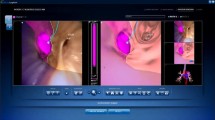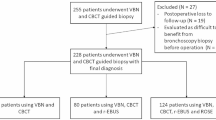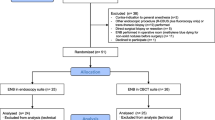Abstract
Purpose
To investigate if electromagnetic navigation bronchoscopy (ENB) improves the diagnostic yield for peripheral lung lesions from that achieved by virtual bronchoscopy navigation (VBN).
Methods
This retrospective study compared the results of 100 ENB-transbronchial lung biopsies (TBLBs) with those of 50 VBN-TBLBs at a single institution.
Results
ENB improved the diagnostic yield significantly compared with VBN (64.0% for 19.4 ± 9.0 mm tumors vs. 46.0% for 27.6 ± 8.9 mm tumors; p < 0.0001). Irrespective of the bronchus sign, ENB was more favorable than VBN, with 81.0% (47/58) achieved by ENB vs. 60.0% (21/35) achieved by VBN in the presence of the positive bronchus sign (p = 0.0283), and 40.5% (17/42) achieved by ENB vs. 13.3% (2/15) achieved by VBN in the absence of the bronchus sign (p = 0.0431). Univariate analysis identified tumor size (p = 0.0048), amount of intravenous sedation (p = 0.0182), registration time (p = 0.0111), minimum distance to target (p = 0.0244), and the bronchus sign (p < 0.0001) as factors that affected the yield significantly for ENB. Multivariate analysis identified the bronchus sign (odds ratio 6.74; 95% CI 1.84–24.7) and the registration time (OR 1.01; 95% CI 1.00–1.02) as significant factors.
Conclusions
Despite the bronchus sign being a significant factor, ENB improved the diagnostic yield of smaller lesions significantly, compared with VBN, regardless of the bronchus sign.




Similar content being viewed by others
References
Stern SH. Nationwide Evaluation of X-ray Trends (NEXT): tabulation and graphical summary of 2000 survey of computed tomography. Conference of Radiation Control Program Directors, Frankfort, 2007
Ost D, Fein AM, Feinsilver SH. Clinical practice. The solitary pulmonary nodule. N Engl J Med. 2003;348:2535–42.
Aberle DR, Adams AM, Berg CD, Black WC, Clapp JD, Fagerstrom RM, et al. National Lung Screening Trial. Research team reduced lung-cancer mortality with low-dose computed tomographic screening. N Engl J Med. 2011;365(5):395–409.
Mehta AC, Hood KL, Schwarz Y, Solomon SB. The evolutional history of electromagnetic navigation bronchoscopy: State of the art. Chest. 2018;154(4):935–47.
Wilson DS, Bartlett RJ. Improved diagnostic yield of bronchoscopy in a community practice: combination of electromagnetic navigation system and rapid on-site evaluation. J Bronchol. 2007;14(4):227–32.
Rivera MP, Mehta AC, Wahidi MM. Establishing the diagnosis of lung cancer: diagnosis and management of lung cancer, 3rd ed: American College of Chest Physicians Evidence-Based Clinical Practice Guidelines. Chest. 2013;143(5 Suppl):e142S – e165.
Sato T, Yutaka Y, Ueda Y, Hamaji M, Motoyama H, Menju T, et al. Diagnostic yield of electromagnetic navigational bronchoscopy: results of initial 35 cases in a Japanese institute. J Thorac Dis. 2018;10(Suppl 14):S1615–9.
Folch EE, Pritchett MA, Nead MA, Bowling MR, Murgu SD, Krimsky WS, et al. Electromagnetic navigation bronchoscopy for peripheral pulmonary lesions: one-year results of the prospective, multicenter NAVIGATE study. J Thorac Oncol. 2019;14(3):445–58.
Seijo LM, de Torres JP, Lozano MD, Bastarrika G, Alcaide AB, Lacunza MM, et al. Diagnostic yield of electromagnetic navigation bronchoscopy is highly dependent on the presence of a bronchus sign on CT imaging: results from a prospective study. Chest. 2010;138(6):1316–21.
Qian K, Krimsky WS, Sarkar SA, Deng Y. Efficiency of electromagnetic navigation bronchoscopy and virtual bronchoscopic navigation. Ann Thorac Surg. 2020;109(6):1731–40.
Memoli JSW, Nietert PJ, Silvestri GA. Meta-analysis of guided bronchoscopy for the evaluation of the pulmonary nodule. Chest. 2012;142:385–93.
Eberhardt R, Anantham D, Herth F, Feller-Kopman D, Ernst A. Electromagnetic navigation diagnostic bronchoscopy in peripheral lung lesions. Chest. 2007;131(6):1800–5.
Gex G, Pralong JA, Combescure C, Seijo L, Rochat T, Soccal PM. Diagnostic yield and safety of electromagnetic navigation bronchoscopy for lung nodules: a systematic review and meta-analysis. Respiration. 2014;87(2):165–76.
Eberhardt R, Morgan K, Ernst A, Beyer T, Herth F. Comparison of suction catheter versus forceps biopsy for sampling of solitary pulmonary nodules guided by electromagnetic navigational bronchoscopy. Respiration. 2010;79:54–60.
Eberhardt R, Anantham D, Ernst A, Feller-Kopman D, Herth F. Multimodality bronchoscopic diagnosis of peripheral lung lesions: a randomized controlled trial. Am J Respir Crit Care Med. 2007;176(1):36–41.
Ma L, Fang Y, Zhang T, Xue P, Bo L, Liu W, Fu E. Comparison in efficacy and safety of forceps biopsy for peripheral lung lesions guided by endobronchial ultrasound-guided sheath (EBUS-GS) and electromagnetic navigation bronchoscopy combined with EBUS (ENB-EBUS). Am J Transl Res. 2020;12(8):4604–11.
Hsu P-K, Wu Y-C. The feasibility of electromagnetic navigation-guided percutaneous microcoil localization for thoracoscopic resection of small pulmonary nodules. J Thorac Cardiovasc Surg. 2019;57(4):e211–4.
Yutaka Y, Sato T, Zhang J, Matsushita K, Aiba H, Muranishi Y, et al. Localizing small lung lesions in video-assisted thoracoscopic surgery via radiofrequency identification marking. Surg Endosc. 2017;31(8):3353–62.
Yutaka Y, Sato T, Matsushita K, Aiba H, Muranishi Y, Sakaguchi Y, et al. Three-dimensional navigation for thoracoscopic sublobar resection using a novel wireless marking system. Semin Thorac Cardiovasc Surg. 2018;30(2):230–7.
Sato T, Yutaka Y, Nakamura T, Date H. First clinical application of radiofrequency identification (RFID) marking system—precise localization of a small lung nodule. JTCVS Techniques. 2020;4:301–4.
Finley RJ, Mayo JR, Grant K, Clifton JC, English J, Leo J, et al. Preoperative computed tomography-guided microcoil localization of small peripheral pulmonary nodules: a prospective randomized controlled trial. J Thorac Cardiovasc Surg. 2015;149:26–31.
Funding
This research did not receive any specific grant from funding agencies in the public, commercial, or not-for-profit sectors.
Author information
Authors and Affiliations
Corresponding author
Ethics declarations
Conflict of interest
We have no conflicts of interest associated with this manuscript to declare.
Additional information
Publisher's Note
Springer Nature remains neutral with regard to jurisdictional claims in published maps and institutional affiliations.
Rights and permissions
About this article
Cite this article
Yutaka, Y., Sato, T., Isowa, M. et al. Electromagnetic navigation bronchoscopy versus virtual bronchoscopy navigation for improving the diagnosis of peripheral lung lesions: analysis of the predictors of successful diagnosis. Surg Today 52, 923–930 (2022). https://doi.org/10.1007/s00595-021-02398-z
Received:
Accepted:
Published:
Issue Date:
DOI: https://doi.org/10.1007/s00595-021-02398-z




